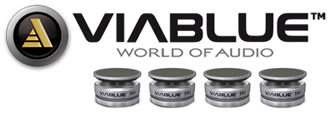New Customer?
Create your accountNo products
Prices are tax included
Understanding sample rates and PCM, DSD, DoP & MQA formats
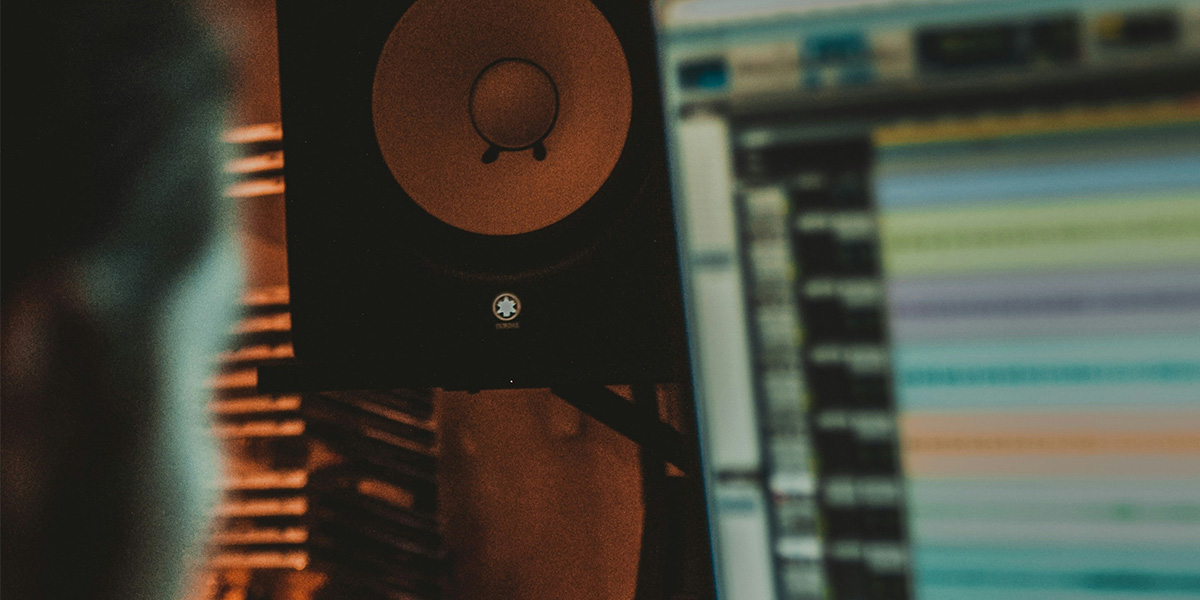
Sample Rates
PCM - Native DSD - DSD DoP - MQA
This article is dedicated to the understanding of sampling rates and the different formats mainly present on the Hi-Fi market, namely PCM, DSD DoP and native as well as MQA. If you can't tell the difference between PCM 24bit 192kHz and 32bit 384kHz, or DSD128 and DSD512, or MQA, you've come to the right place. The sampling rate supported by a device determines the quality of the audio data it is able to process. It can therefore be essential, especially when choosing a device such as a DAC!
The difference between analog signals and digital audio data
When we talk about sampling rates, we're talking about digital, but we mustn't forget how an audio file is created. Indeed, depending on the type of music, audio recording can often be made directly from synthetic or already digitized sounds, or via a recording session by a band or artist. That's why it's important to distinguish between analog signals and digital audio data. Audio capture is represented by voltage variations over time within an electrical cable. For example, if you're recording a voice, your microphone actually converts pressure waves into voltage variations over time, which are then transmitted via an analog modulation cable. This voltage variation is represented, for example, by the intensity of magnetic variation on cassettes, and by the variation in groove size on vinyl records. Today, however, all recordings are digitized and converted into a sequence of 0's and 1's, so that they can be processed or simply stored on a computer. In digital recording, the original waveform is divided into individual sections, called samples. This work is generally carried out by a DAC/ADC chip (Digital to Analog Converter / Analog to Digital converter).
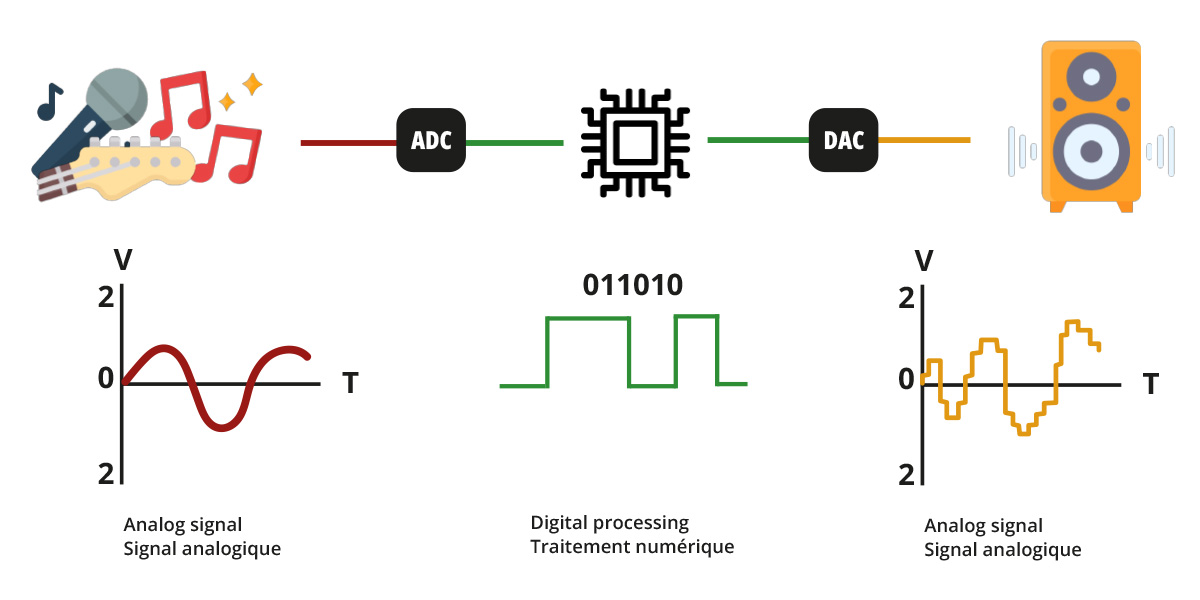
The concept of a sampling rate
To understand the principle of a sampling rate, there are two essential parameters to consider. Firstly, the sampling frequency expressed in kilohertz, but also the bit depth.
The sampling frequency corresponds to the number of samples taken per second. The higher the sampling rate, the better the file quality. This allows us to get as close as possible to the original analog waveform.
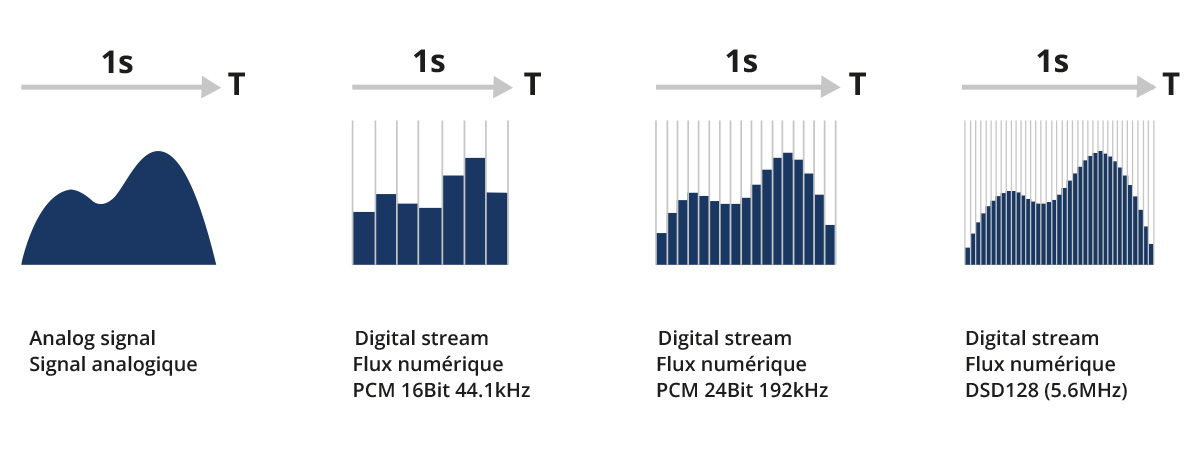
Bit depth is the difference between the lowest sample and the highest sample. In audio, we often speak of 16bit, 24bit or 32bit, or even 64bit, although this is rare. To put it more clearly, the higher the bit depth, the higher the dynamic range, expressed in dB, of your music file. The CD standard, for example, is 16bit, allowing an amplitude made up of 65,536 possible quantization levels.
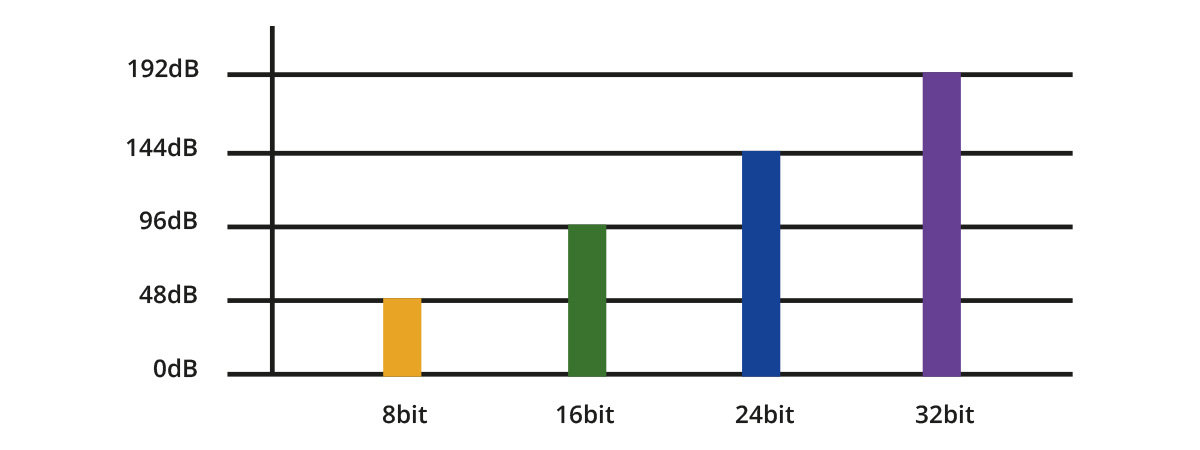
The 44.1 kHz CD standard and the various audio codecs
To reproduce a given frequency, the sampling rate must be at least twice that frequency, according to the Nyquist-Shannon sampling theorem. Given that the human ear is able to perceive sounds between 20Hz and 20kHz, it's only logical that 44.1kHz has become the sampling rate standard. If the sampling rate is lower than 44.1kHz, converters and processing chips risk misinterpreting high frequencies. This standard was established by Sony and Philips in the early 80s, prior to the launch of the CD format in 1982 in the USA and 1983 in France. When first marketed, CDs were labelled with a SPARS code, i.e. inscriptions indicating the three main phases of the recording process, with “A” for analog and “D” for digital:
- AAD: Initial analog recording, analog mixing/editing and digital mastering.
- ADD: Initial analog recording, digital mixing/editing and digital mastering.
- DDD: Initial digital recording, digital mixing/editing and digital mastering.
- Etc.
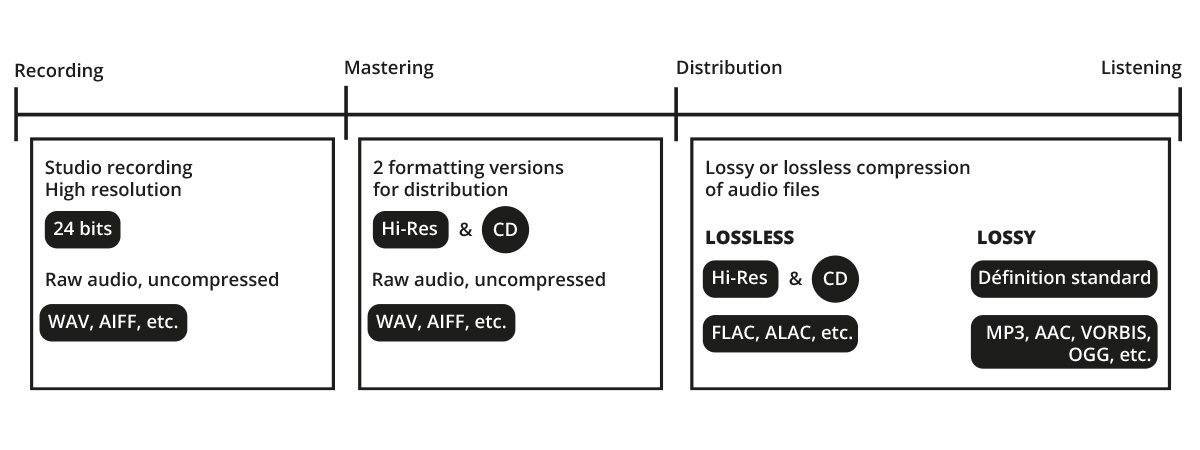
Compression in the digital era
With the rise of the Internet, the music industry found itself in a state of change, forced to keep up with consumer habits and usage patterns. However, in the early days of the Internet, even if it was possible to transfer an e-mail, there was still no question of transferring large files. Even 16bit was considered too large, so the 24bit of original recordings... This is why the principle of compression emerged, creating the famous MP3 format. There are two distinct methods of compression: lossy and lossless.
Lossy compression (MP3, AAC, WMA, OGG): with lossy compression, some parts of the original audio recording are completely removed. For example, if a very soft sound is partially covered by a very loud sound, it is likely to be removed from the recording without making much difference to your ears. However, overall, this makes the final rendering much less textured, lacking certain details.
Lossless compression (FLAC, ALAC): this is the best way of compressing an audio file without degrading its quality. It's the same principle as a ZIP file: when you open your audio file, you “decompress” the file to take full advantage of all the data.
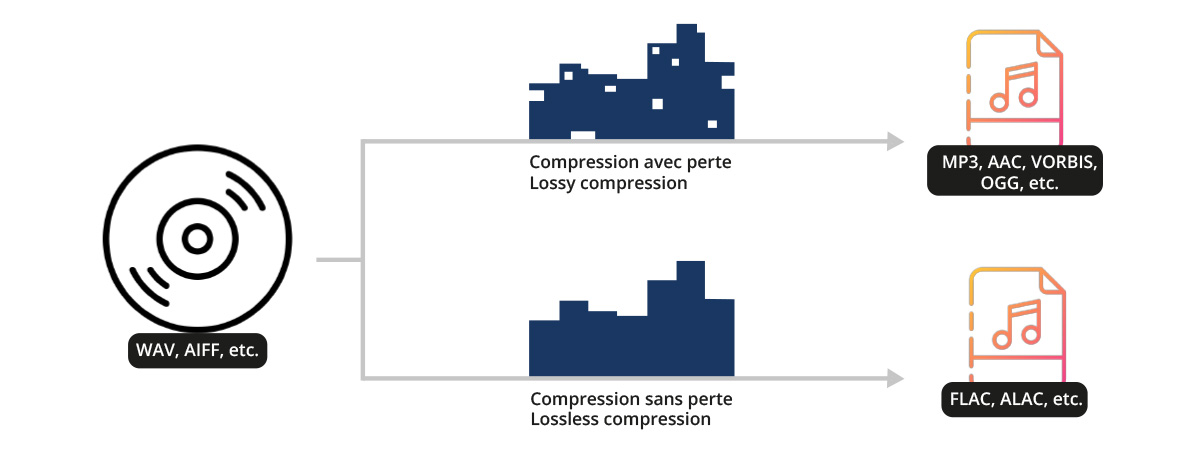
But then, how do you find your way between PCM, DSD, DSD DoP and MQA?
In today's HiFi world, there are indications such as PCM 32bit 768Khz, DSD512 or MQA. In fact, this allows you to determine what type of sampling your device is capable of supporting. As technologies have evolved, more and more platforms offer the possibility of enjoying high-definition recordings and files for your music listening sessions.
PCM encoding: Pulse-Code Modulation (PCM) is one of the processes used to digitalize an electrical signal in the form of a stream. It comprises three operations: sampling, quantization and coding. Each sample is processed independently, avoiding the need for data encryption or compression. For example, if your DAC supports 32bit 384kHz PCM, it will be able to convert over a dynamic range of 192dB, pushing the noise floor, with sampling every 1/384000s for a curve as close as possible to an analog format. The higher the sampling frequency, the less interpolation processing is required between the different samples.
Historically, it was a certain Alec Reeves who contributed to the development of coded pulse modulation. He filed a patent in the late '30s and was the first to sample a telephone signal. But it was only with the advent of transistors, which replaced tubes, that the process was democratized, appearing in the first audio processors in the 70s. As you will have gathered, this is the encoding used on CD-AUDIO (PCM 16Bit 44.1kHz). But some observed at the time that certain harmonics and high frequencies were destroyed by the low-pass cut filter applied during CD playback. To compensate for this, CD players used interpolation for oversampling. It was partly this problem that prompted Sony and Philips to develop DSD via the SA-CD format.
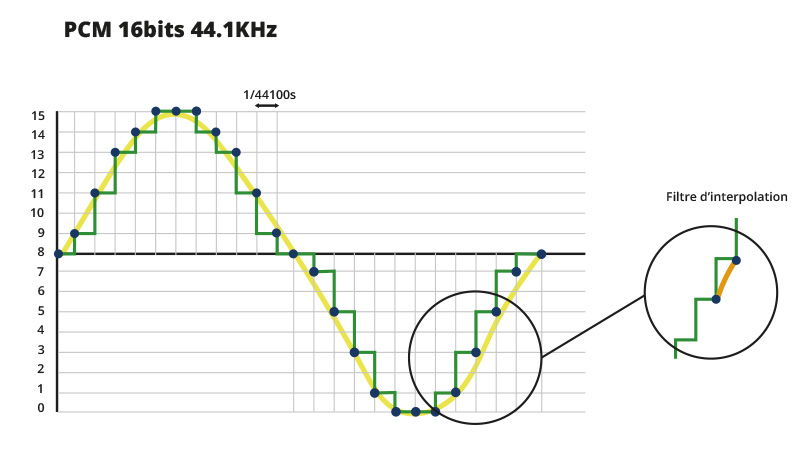
DSD encoding: a direct competitor to PCM, DSD or “Direct Stream Digital” arrived in the late 90s, developed in particular for SA-CD (Super-Audio CD) technology by Sony and Philips. The digital stream was subject to DST (Direct Stream Transfer) lossless compression, to increase the storage capacity of SA-CD discs. In concrete terms, DSD is a method of storing a delta-sigma modulated signal. This involves encoding the signal at a very high sampling frequency to a depth of 1 bit. This single bit still allows a dynamic range of 120dB over a bandwidth of up to 1000kHz. DSD64 (2.8MHz), for example, corresponds to a 64x higher sampling rate than CD. The same applies to DSD128 (5.6MHz), DSD256 (11.2MHz), DSD512 (22.6MHz), DSD1024 (45.2MHz), etc. As this technique does not use a brutal filter for high frequencies, it provides a high fidelity restitution of the original signal, even when the higher harmonics are concerned. It also simplifies conversion work for ADCs and DACs. In particular, this method enabled the commercialization of multichannel at the time, since the 5.1 surround format was only available in DVD-Audio and SA-CD formats for the general public, whereas the classic CD was limited to two channels for lack of space. Many albums were even released with a true 4.0 channel mix to achieve spatialization effects (albums by Bjork, Aerosmith, Depeche Mode, Elthon John and many others, to name just a few). You'll find a number of websites referencing numerous multichannel productions, such as surrounddiscography.com or sa-cd.net.
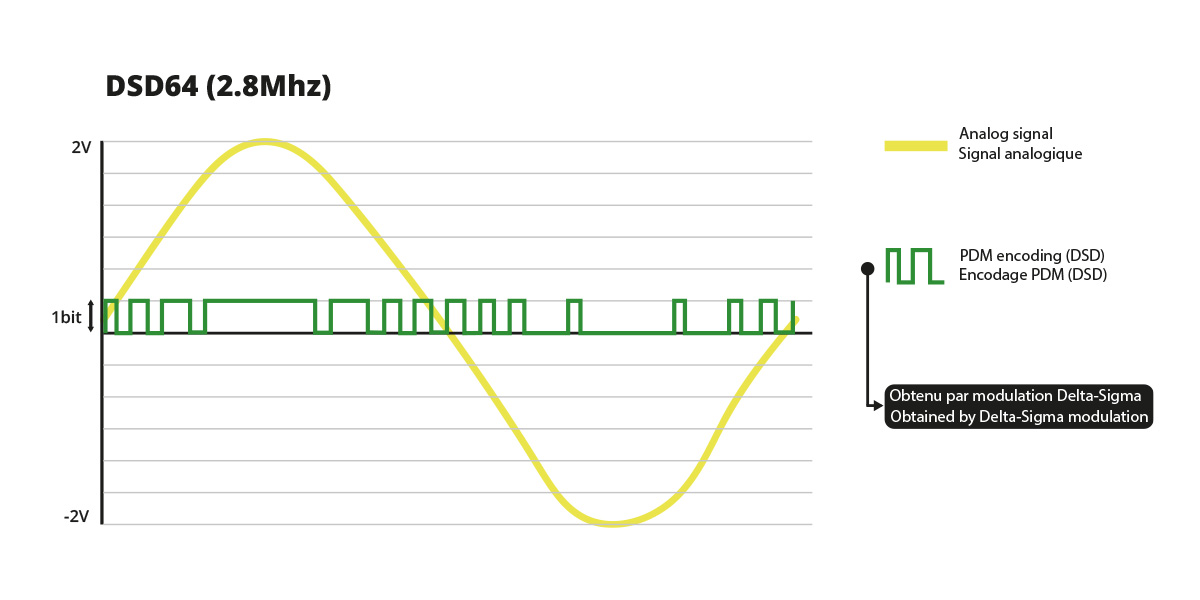
DSD DoP (DSD over PCM) encoding: DSD DoP actually uses a PCM container (frame) to store a DSD stream. This makes it technically possible to write a binary stream to an interface that only handles PCM. Native DSD is often only supported via USB connection. DSD DoP, on the other hand, enables devices to support DSD streams even though their interface is designed exclusively for a PCM stream. This is particularly the case with optical Toslink and coaxial SPDIF connections. The DSD DoP processing protocol is based on Bit-Perfect, enabling lossless recovery of the original DSD stream. DSD DoP is therefore in no way a “sub-DSD”. Today, most devices have a USB connection compatible with native DSD.

MQA: MQA (Master Quality Authenticated) is an audio codec that appeared in 2014, based on PCM encoding and using the FLAC format. This codec has been specially designed for streaming and downloading files, since its main advantage is that it enables an extreme level of compression (up to 50% of a traditional HD file). The original stream is downsampled to 48kHz for 17-bit quantization. This is made possible by a technique that retains a 13-bit lossless compressed core and 4-bit lossy compressed metadata to reconstitute a 24-bit 96kHz stream. The real advantage, then, lies with streaming platforms. Opinions differ on the use of this technology and on the real benefits for listeners (Remember Neil Young's opinion on the subject). Technically, MQA is represented by different layers that would be encapsulated by compression and then “unfolded” in their entirety to theoretically enable the rendering of a high-resolution format. However, this would only be possible with the brand's proprietary and compatible technologies. If your device is not compatible, only the first layer, equivalent to lossy compression, will be supported by your device, thanks to its universal FLAC format. If you'd like to learn more about MQA, we invite you to visit Audiophile Style's article on the subject, which may answer your more advanced technical questions.
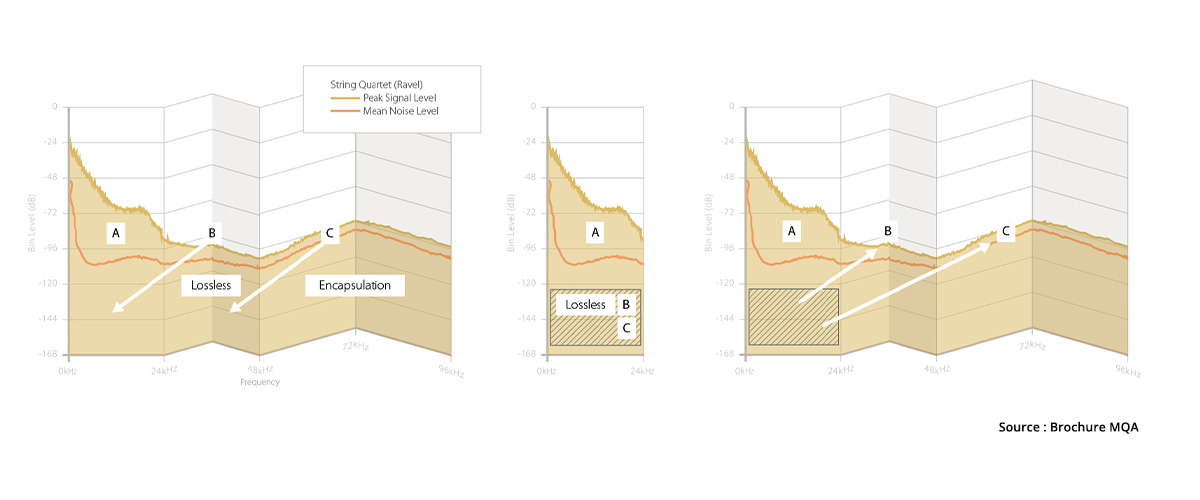
Conclusion
To conclude on this subject that divides the audiophile community, we invite you to carry out your own tests with different files and your own Hi-Fi installation. We also suggest this thought-provoking quote from Brian Eno:
"Whatever you now find weird, ugly, uncomfortable and nasty about a new medium will surely become its signature. CD distortion, the jitteriness of digital video, the crap sound of 8-bit - all of these will be cherished and emulated as soon as they can be avoided. It’s the sound of failure: so much modern art is the sound of things going out of control, of a medium pushing to its limits and breaking apart. The distorted guitar sound is the sound of something too loud for the medium supposed to carry it. The blues singer with the cracked voice is the sound of an emotional cry too powerful for the throat that releases it. The excitement of grainy film, of bleached-out black and white, is the excitement of witnessing events too momentous for the medium assigned to record them."
Rechercher dans le blog
Blog categories
Latest Comments
Audiophonics Team
on DIY Tutorial - PiCorePlayer - Installing...Pierre Bommel
on Lecteur réseau Opensource : SolutionsPierre Bommel
on DIY Tutorial - PiCorePlayer - Installing...Audiophonics Team
on Tutorial DIY - Power cable ELECAUDIO CS-331B

















![[GRADE B] AUDIOPHONICS HPA-S500ET Power Amplifier Class D Stereo Purifi 1ET7040SA 2x500W 4 Ohm](https://www.audiophonics.fr/68112-thumb_default/audiophonics-hpa-s500et-stockb.jpg)












